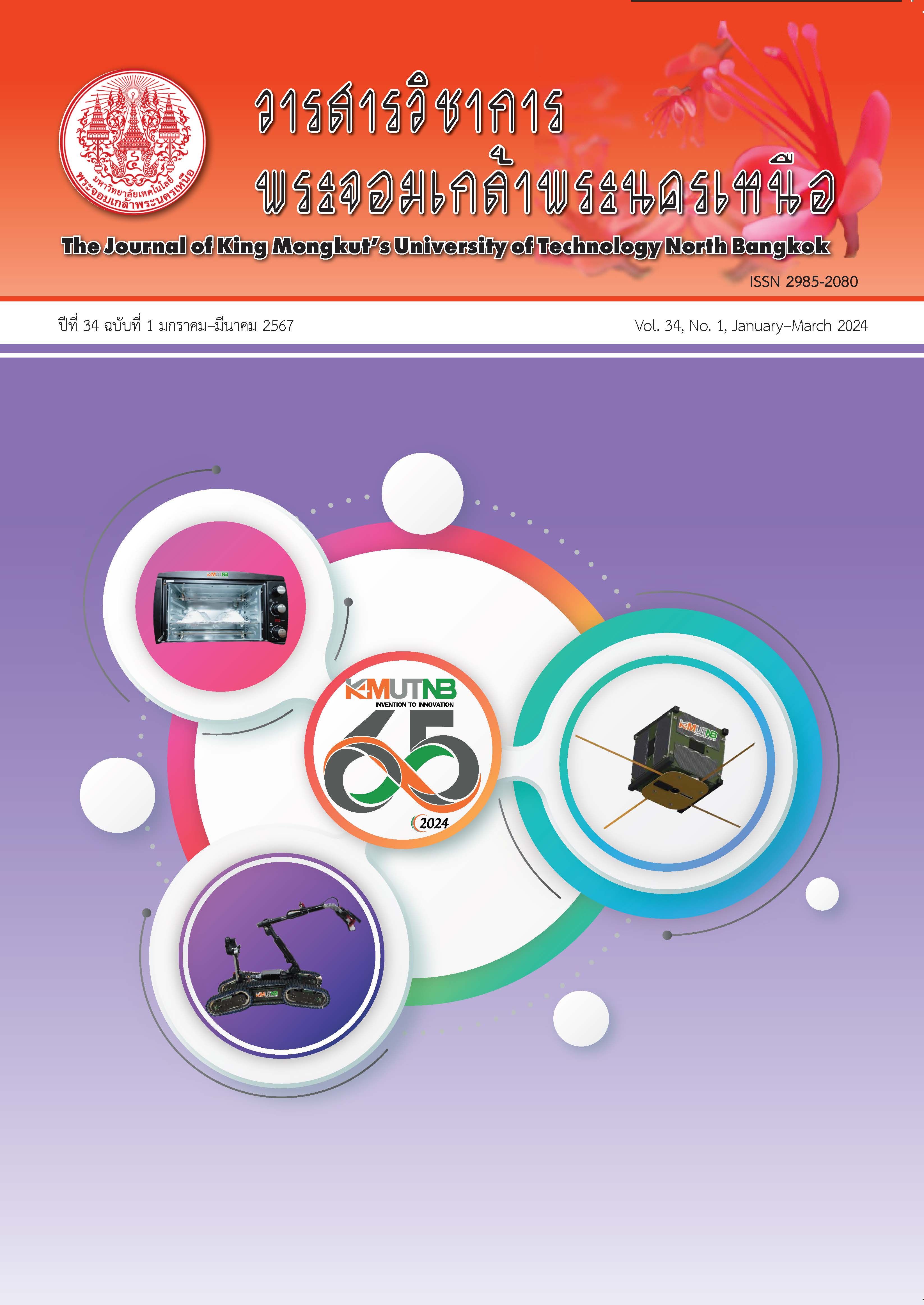การพัฒนาแบบจำลองการเสื่อมสภาพผิวทางแอสฟัลต์โดยวิธีลูกโซ่มาร์คอฟ: กรณีศึกษาทางหลวงหมายเลข 4 ช่วง กม. 67+334 ถึง กม. 111+457
Main Article Content
บทคัดย่อ
งานวิจัยนี้ได้พัฒนาแบบจำลองการเสื่อมสภาพผิวทางแอสฟัลต์ด้วยวิธีลูกโซ่มาร์คอฟ โดยพิจารณาปัจจัยที่ส่งผลต่อความเสื่อมสภาพผิวทางจากปริมาณจราจร น้ำหนักบรรทุกและปริมาณน้ำฝน บนทางหลวงหมายเลข 4 ช่วงกม. 67+334 ถึง 111+457 เพื่อศึกษาความเป็นไปได้ในการใช้แบบจำลองที่สร้างจากวิธีลูกโซ่มาร์คอฟมาคาดคะเนความเสื่อมสภาพผิวทางแอสฟัลต์ โดยนำข้อมูลดัชนีความขรุขระสากลในช่วงปี พ.ศ. 2556 ถึง พ.ศ. 2561 เป็นดัชนีในการบ่งบอกสภาพผิวทาง จากนั้นทำการสอบเทียบแบบจำลองจากข้อมูลจริง จากผลการศึกษาพบว่าความสัมพันธ์ระหว่างอายุผิวทาง (ปี) และดัชนีความขรุขระสากล สอดคล้องกับสมการเอกซ์โพเนนเชียล โดยมีค่า R-Square (R2) จากสมการที่สร้างจากปัจจัยที่ศึกษาอยู่ในช่วง 0.892-0.987 ทั้งนี้มีข้อเสนอแนะว่าหากมีจำนวนข้อมูลที่นำมาสร้างแบบจำลองที่มากเพียงพอ จะสามารถนำแบบจำลองที่สร้างจากวิธีลูกโซ่มาร์คอฟมาใช้ในการคาดคะเนความเสื่อมสภาพของผิวทางแอสฟัลต์ที่ทำการจัดกลุ่มปัจจัยจากปริมาณจราจร น้ำหนักบรรทุกและปริมาณน้ำฝน ซึ่งจะเป็นประโยชน์สำหรับการวางแผนการจัดสรรงบประมาณในงานบำรุงรักษากับหน่วยงานที่เกี่ยวข้องต่อไป
Article Details

อนุญาตภายใต้เงื่อนไข Creative Commons Attribution-NonCommercial-NoDerivatives 4.0 International License.
บทความที่ลงตีพิมพ์เป็นข้อคิดเห็นของผู้เขียนเท่านั้น
ผู้เขียนจะต้องเป็นผู้รับผิดชอบต่อผลทางกฎหมายใดๆ ที่อาจเกิดขึ้นจากบทความนั้น
เอกสารอ้างอิง
S. Thamrongkulrat, “Development of work load and routine maintenance cost for asphalt and concrete pavements,” Road Research and Development Center, no. RD. 155, 1996.
Department of Rural Roads, “Pavement distress identification manual,” Local Road Maintenance Management System, 2013.
Department of Rural Roads, “A report summarizing condition pavement by visual inspection rating,” Department of Rural Roads, 2012.
P. Tussawil, “Development of road condition index for an efficient highway maintenance analysis: Case study of flexible pavement maintenance in the eastern region by using HDM-4,” M.S. thesis, Department of Civil Engineering, Faculty of Engineering, Kasetsart University, 2008 (in Thai).
W. Subsompon, P. Chinudomsub, J. Ponprasert, and P. Siriakarakornkun, “Development of asphalt pavement deterioration model using IRI in Thailand,” Engineering Journal of Research and Development, vol. 11, no. 4, pp. 29–35, 2000 (in Thai).
S. A. Arhin, L. N. Williams, A. Ribbiso, and M. F. Anderson, “Predicting pavement condition index using international roughness index in a dense urban area,” Journal of Civil Engineering Research, vol. 5, no. 1, pp. 10–17, 2015.
N. Maneedang, B. Kunsuwan, and N. Kunsuwan, “The study and the comparison of the rainfall effects on the asphalt concrete surface,” National Convention on Civil Engineering, vol. 23, 2018 (in Thai).
W. Wongweeranimit, “Development of a deterioration model for flexible pavement in low traffic volume roads using markov chains,” M.S. thesis, Department of Civil Engineering, Faculty of Engineering, Chulalongkorn University, 2004 (in Thai).
W. Pocarattananan and W. Subsompon, “Application of deterioration model of flexible pavement in low volume roads using markov chains for pavement maintenance planning,” Research and Development Journal, vol. 19, no. 1, 2008.
S. Surbjakrod, “Development of asphalt concrete pavement deterioration models for Thailand national highways using markov chains,” M.S. thesis, Department of Civil Engineering, Faculty of Engineering, Chulalongkorn University, 2008 (in Thai).
X. Chen, Q. Dong, H. Zhu, and B. Huang, “Development of distress condition index of asphalt pavements using LTPP data through structural equation modeling,” Transportation Research Part C: Emerging Technologies, vol. 68, pp. 58–69, 2016.
M. Fakhri and R. S. Dezfoulian, “Pavement structural evaluation based on roughness and surface distress survey using neural network model,” Construction and Building Materials, vol. 204, pp. 768–780, 2019.
M. M. Hasan, A. A. Rahman, and R. A. Tarefder, “Investigation of accuracy of pavement mechanistic empirical prediction performance by incorporating level 1 inputs,” Journal of Traffic and Transportation Engineering (English Edition), vol. 7, no. 2, pp. 259–268, 2020.
M. A. Ismail, R. Sadiq, H. R. Soleymani, and S. Tesfamariam, “Developing a road performance index using a Bayesian belief network model,” Journal of the Franklin Institute, vol. 348, no. 9, pp. 2539–2555, 2011.
J. G. Kemeny and J. L. Snell, Markov chains. Springer-Verlag, New York, 1976.
N. Tawanna, F. Takkabutr, A. Kesutha, R. Wongsathan, A. Nuangnit, and N. Wongsinlapamorakot, “Improvement performance of PV water pumping system using MPPT-based modified P&O Controller: Modeling, setting experimental package and analysis,” The Journal of KMUTNB, vol. 31, no. 1, pp. 5–15, 2021 (in Thai).
N. Koatbua and K. Rungjang, “Choice model for long distance travels by train and application to logit model for lower-northeastern line,” The Journal of KMUTNB, vol. 31, no. 3, 2021 (in Thai).
H.-S. Baik, H. S. Jeong, and D. M. Abraham, “Estimating transition probabilities in markov chain-based deterioration models for management of wastewater systems,” Journal of Water Resources Planning and Management, vol. 132, no. 1, pp. 15–24, 2006.
A. A. Butt, M. Y. Shahin, K. J. Feighan, and S. H. Carpenter, “Pavement performance prediction model using the Markov process (no. 1123),” Transportation Research Record, 1987.
Ratchaburi Rural Road Office. (2013). Report the Operation Progress 2013–2018. Ratchaburi Rural Road Office. Ratchaburi, Thailand [Online]. Available: https://ratchaburi.drr.go.th/
N. Maneedang, N. Maneedang, B. Kunsuwan, and N. Kunsuwan, “Study and comparison of physical factors effecting on asphalt road surface,” National Convention on Civil Engineering, vol. 24, 2017 (in Thai).

